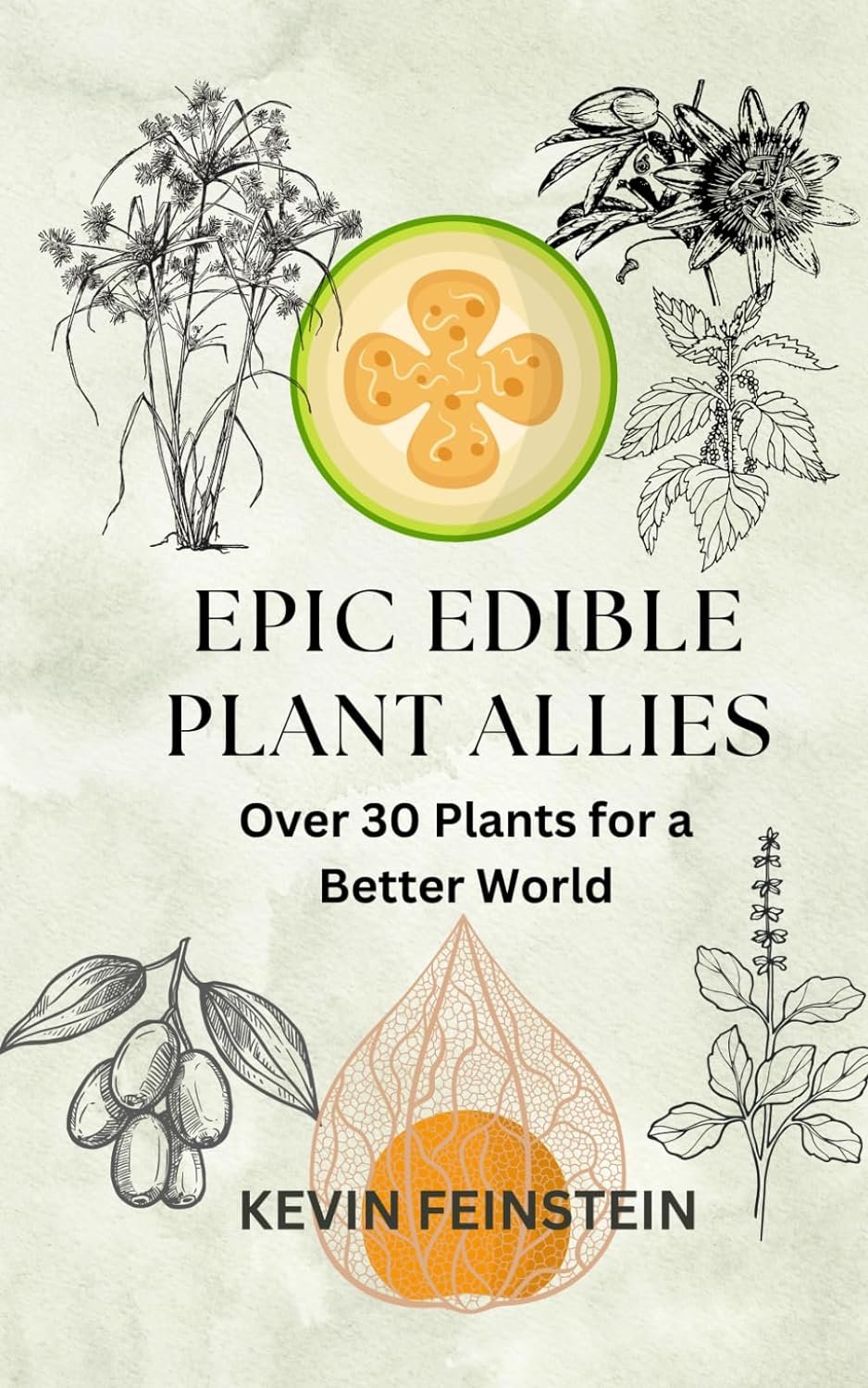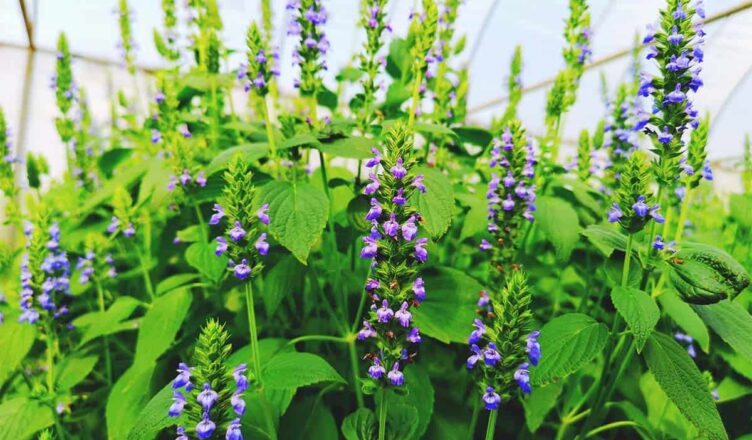The following is an excerpt from the new book,
Maybe I am a grouchier gardener than I like to think, so go ahead get out all the jokes now. Cha-Cha-Cha Chia! The infamous commercial inevitably comes up whenever I mention this amazing plant, which of course causes me to sigh heavily and roll my eyes.
So what is a chia pet, really? A chia pet takes the somewhat unique ability of chia seeds to “gel up” when hydrated, and thus are easily spread and will stick to pretty much any shape. You can put “chia beards” on things for instance or create similar art projects. The seeds sprout and grow very easily, another aspect that lends itself to novelty applications as such.
Hopefully you have heard about the health benefits of consuming chia seeds, as this information has crossed over into the mainstream over the last twenty years or so. They are high in antioxidants, calcium, protein, and healthy fat — an Omega 3 dominant fat that is hard to come by. Where they shine the most, in my opinion, is their fiber content — specifically their soluble fiber content. Insoluble fiber can be thought of as roughage — such as broccoli stalks. Soluble fiber is quite different. It is typically more necessary for most people and harder to come by in foods. Chia is one of best most amazing sources of soluble fiber in the world, and along with it comes all the other nutritional benefits listed above.
The only drawback for chia from a health perspective is that is high in lectins, something that certain people should avoid and most of us would do well to not overconsume.
Chia is super easy to eat and prepare,
one of my favorite aspects of chia. You take some chia seeds and soak them in water. They gel up, just like in the commercial, and you can drink this straight, put it in smoothies, add it to yogurt or kefir, make all sorts of puddings with it, and even use it as an egg substitute in cooking.
We like to put six tablespoons or so in a quart mason jar of water each night, let it gel up, stir it well, and place it in the fridge for the next day. My son absolutely loves it and we sometimes call him “Chia Man!” in jest. He’ll drink it straight and loves it mixed in his yogurt or even cottage cheese. It is a great way for kids, or anyone, to get that extra fiber.
One of the things I have noticed with my son loving it so much is that when you drink it straight, it really is satisfying from a hydration perspective. It quenches the thirst far more than just water. I suspect that is because the living seeds, when they gel up after being hydrated, create structure for the water. Structured water is an entirely other topic unto itself, and its proponents suggest getting it in the following ways: living spring water, water vortexer devices, products like analemma, and eating fruit like watermelon. Chia is by far the most convenient way to structure your water that I have encountered.
Chia, in parts of Mexico and Central America, where it is from, was famously used by warriors and especially runners of different groups there. The chia seeds gave them long lasting energy (and hydration) in order to accomplish incredible feats of endurance and athleticism.
How to Grow Chia:
Chia is super easy to grow, with a caveat that I’ll talk about a bit later. The seeds sprout easily, as mentioned. They can be planted dry or hydrated first before planting, just as you would if making a chia pet or soaking for consumption.
Chia is in the mint family. In fact it is in the genus Salvia which is to say it is a sage. Although it does share this familial relationship with many of our common herbs, it is still widely pest and disease resistant. It is also pretty tolerant of poor soils and even drought. Its attractive clusters of purple flowers also attract lots of beneficial pollinators, including bees.
I first grew chia by accident by simply throwing out some soaked chia that was left in the fridge for too long. It grew and sprouted only a few feet away from the chicken coop door, on a steep, eroded hill with terribly poor soil, near a black walnut tree — an extremely inhospitable environment for most plants. They not only grew but thrived and flowered, despite the chickens, the soil, and the high heat and drought we had that summer. I never watered them or cared for them in any way. Did they produce more chia seeds for me — no, but we’ll get that next.
Chia is a subtropical plant that can be grown as an annual, anywhere with at least some moderate (or even super high) heat in the summer. But the issue with chia is that it possesses what they call day length sensitive flowering. That means the plants only start to flower once the nights become as long or longer than the days. So not starting to flower until fall when this is triggered, in most places in North America, they will succumb to frost before their seeds can ripen. That is what happened to mine.
They can be grown for seed in warmer parts of the country such as Florida and parts of California and Texas, for instance. The normal, commercial chia is Salvia hispanica, and there are other species as well. One of them is Salvia columbariae, which is native to the warm parts of the desert Southwest and California. These plants are wonderful, and when I lived in California, I always dreamed of growing fields of them. However, they are very small plants, and they produce very little seeds compared to the standard, S. hispanica — the normal chia.
Another variety you can find is Saliva tiliaefolia, often called Tarahumara chia, from the name the Spanish gave to the group of people called Raramuri, who utilized chia to feed their famous long distance runners. This chia is from higher altitude areas and is not dependent on day length to induce flowering, thus has a much higher potential to be grown in colder areas. Experimental Farm Network offers seeds from this species that have been selected to survive in more northern climates.
I grew the Raramuri chia last year with some success. It produced a beautiful plant that attracted lots of bees. I found that they fell over without support, unlike the “normal” chia, and they produced fewer seeds overall. But it was far better than my experience with S. columbariae chia and was super promising, nonetheless.
There is a company called Heartland Chia, based out of Kentucky that has bred a variety of the “normal” chia that does not have day length sensitive flowers. I grew that last year with great success.
In fact, these were the first seeds that my son (not even 18 months at the time) and I planted together. Although still very young, he knew what chia seeds were. I carried him, and we went around tossing the tiny seeds all over the garden — and had to, of course, eat a few along the way. This was just a little experiment we did, but at the end of summer, we had several ripening on the plants. We would go out on his suggestion and strip the dried flower and seed heads off the stalk. I’d hold the fluff in my palm, and he would blow the dried flower bits and chaff away, leaving the beautiful tiger-striped seeds in my palm. We would eat them together — great nature and food bonding experience for us.
Harvesting the seeds is the probably the biggest drawback of growing chia, but if done correctly, and especially if you have any commercial equipment, it is not that difficult. Chia is fairly productive when you think how dense the seeds are and how much gel they can make, but is on the lower side compared to other commercial crops. If you want to grow chia for more than its beauty, pollinator attraction, or novelty, you’ll need a field of it.

Recipe: Chia Pudding
There are so many recipes online for chia pudding that I suggest finding one that sounds good to you and making it. I will suggest however, if you are not looking to make something fancy to serve to impress people, but like us, like to make something that is easy and delicious to conveniently feed your family, do the following:
Take 6 or 7 Tbs of chia seeds and soak them in a quart of water. Stir to break up any clumps and let the mixture completely “gel up.”
Add this gel to yogurt or coconut milk along with some fruit, and stir. Strawberries, raspberries, and pomegranate are my favorites. If you need it to be sweeter, a spoonful of maple syrup or honey is nice, and walnuts or pecans are also nice additions.


